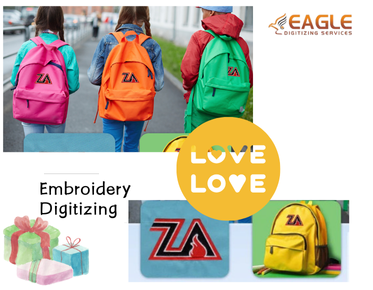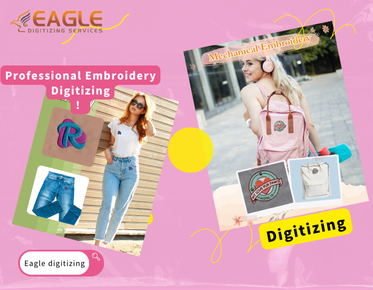Weighing Vector Art in Digitized Embroidery: Pros and Cons
Digitized embroidery represents a fascinating crossroads where traditional craftsmanship meets cutting-edge technology. It enables intricate designs to be reproduced with remarkable precision and efficiency, making it a vital tool for everything from custom apparel to large-scale industrial applications. In modern craft and industry, it offers an innovative way to translate artistic visions into fabric, with the added benefits of consistency and repeatability. For the top-notch online embroidery digitizing, don't hesitate to get in touch with us.
Advantages of Using Vector Art in Digitized Embroidery
Precision and Scalability
Perfecting Details: How Vector Art Ensures Sharp, Clear Designs
Vector art excels in creating designs with impeccable clarity and detail. Unlike raster images, which can become pixelated when enlarged, vector graphics maintain their sharpness because they are based on mathematical equations rather than pixels. This characteristic is particularly advantageous in embroidery, where fine details and crisp lines are crucial. The ability to render intricate patterns with pinpoint accuracy ensures that every stitch is executed as envisioned, enhancing the overall quality of the finished product.
Scaling Without Losing Quality: The Power of Vector Graphics
One of the standout features of vector graphics is their scalability. Whether a design is scaled up for a large banner or down for a delicate monogram, vector art retains its original quality. This flexibility is invaluable in embroidery, where designs might need to be adjusted to fit various sizes without compromising on detail or clarity. The power of vector graphics lies in their ability to adapt to different dimensions while preserving the integrity of the design.
Efficiency in Design
Streamlining the Design Process: From Concept to Stitch
Vector art simplifies the design process by providing a clear, editable format that translates directly into embroidery instructions. Designers can easily create, modify, and perfect their designs in vector format, which then seamlessly integrates with embroidery software. This streamlined workflow reduces the time and effort required to prepare designs for stitching, making it easier to bring concepts to life quickly and efficiently.
Time-Saving Benefits of Using Vector Art for Complex Designs
The use of vector art significantly speeds up the creation of complex embroidery designs. Since vector graphics can be precisely edited and scaled without losing quality, designers can experiment with intricate patterns and modifications more swiftly. The ability to make adjustments in the digital realm before committing to physical embroidery saves valuable time and resources, especially when working with elaborate or custom designs.
Customization and Flexibility
Easily Adjusting Designs: How Vector Art Allows for Modifications
Vector art offers unparalleled flexibility when it comes to design adjustments. Whether you need to alter colors, resize elements, or modify shapes, vector graphics can be easily edited without loss of quality. This adaptability is especially useful in embroidery, where clients often request changes to suit their preferences or specifications. The ease with which vector art can be customized ensures that designs can be tailored to meet diverse needs.
Creating Unique Embroidery Designs with Vector Art Customization
With vector art, creating one-of-a-kind embroidery designs becomes a straightforward task. Designers can experiment with various elements, such as patterns, colors, and textures, to craft unique and personalized pieces. The ability to modify and refine designs with precision allows for the creation of exclusive embroidery patterns that stand out in both aesthetic appeal and originality.
Consistency and Accuracy
Achieving Uniformity: How Vector Art Ensures Consistent Results
Vector art is instrumental in achieving uniformity in embroidery. Because vector graphics are based on mathematical equations, they ensure that every instance of a design is reproduced with exacting consistency. This reliability is crucial in both small-scale custom projects and large-scale commercial production, where maintaining a high standard of quality across multiple items is essential.
Reducing Errors: How Vector Graphics Improve Accuracy in Embroidery
The precision of vector graphics helps minimize errors in the embroidery process. By providing clear, accurate instructions for each stitch, vector art reduces the likelihood of discrepancies between the design and the finished product. This accuracy is particularly beneficial for complex designs with intricate details, ensuring that the final embroidery closely matches the designer's original vision.
Integration with Embroidery Software
Seamless Compatibility: How Vector Art Integrates with Embroidery Programs
Vector art integrates seamlessly with embroidery software, streamlining the process of converting designs into stitch patterns. Most embroidery programs are designed to work with vector formats, allowing for easy import and conversion. This compatibility ensures that designers can efficiently transition from digital art to physical embroidery, leveraging the full potential of both technologies.
Enhancing Software Capabilities: Benefits of Vector Art in Embroidery Digitizing
The use of vector art enhances the capabilities of embroidery software, providing a robust foundation for digitizing complex designs. Vector graphics offer a precise framework that software can easily interpret and translate into embroidery commands. This synergy improves the overall functionality of embroidery programs, enabling designers to produce high-quality, intricate designs with greater ease.
Cost-Effectiveness
Reducing Costs with Efficient Design Processes
Vector art contributes to cost-effectiveness in embroidery by streamlining the design process. The efficiency gained from working with vector graphics reduces the time and resources needed for design preparation. By minimizing errors and the need for extensive revisions, vector art helps keep costs down, making it a practical choice for both individual projects and large-scale production.
The Long-Term Savings of Using Vector Art for High-Quality Embroidery
Investing in vector art can lead to long-term savings by ensuring high-quality results and reducing the frequency of design corrections. The precision and scalability of vector graphics result in fewer issues during production, which translates to lower costs for materials and labor. Over time, the benefits of using vector art can outweigh the initial investment, offering substantial savings in both time and money.
Disadvantages of Using Vector Art in Digitized Embroidery
Complexity in Design
Potential Drawbacks of Overly Complex Vector Designs
While vector art offers many advantages, overly complex designs can pose challenges in embroidery. Highly detailed vector graphics may result in intricate stitching patterns that are difficult to execute accurately. Complexity can also increase the likelihood of issues during the stitching process, such as thread breaks or misalignments. Balancing detail with practicality is essential to ensure that designs are both visually appealing and feasible for embroidery.
Balancing Detail and Practicality: Avoiding Overcomplicated Embroidery Files
To avoid problems with overly complex designs, it is important to strike a balance between detail and practicality. Simplify intricate elements where possible and focus on essential aspects of the design to ensure that it translates well into embroidery. By considering the practicalities of stitching, designers can create beautiful yet manageable embroidery files that achieve the desired effect without unnecessary complications.
Software and Skill Requirements
The Learning Curve: Understanding the Tools Needed for Vector Art
Using vector art effectively requires a certain level of skill and familiarity with graphic design tools. Designers must be proficient in vector graphic software and understand how to create and manipulate vector files. The learning curve associated with mastering these tools can be steep for beginners, potentially posing a barrier to those new to digital design and embroidery.
Software Compatibility Issues: Challenges with Different Programs
Software compatibility issues can arise when working with vector art in embroidery. Different programs may handle vector files in varying ways, leading to potential inconsistencies or errors during the conversion process. Ensuring that your vector art is compatible with the embroidery software used is crucial for achieving seamless results and avoiding complications.
File Size and Processing Power
Managing Large Vector Files: Potential Impacts on System Performance
Large vector files can impact system performance, especially if they contain complex or detailed elements. Managing file size and optimizing graphics are important to prevent slow processing times or crashes. Designers must balance the level of detail in their vector art with the capabilities of their hardware to ensure smooth performance during the design and embroidery process.
Hardware Requirements: Ensuring Your Equipment Can Handle Vector Art
Vector art often requires substantial processing power and memory, particularly when working with intricate designs. Ensuring that your hardware meets the requirements for handling vector files is essential for efficient design work. Upgrading equipment or optimizing software settings can help manage the demands of vector art and prevent performance issues.
Design Limitations
Limitations in Creating Certain Textures and Effects
While vector art excels in many aspects, it may have limitations in creating certain textures and effects. Vector graphics are inherently designed for clean, crisp lines and shapes, which may not always capture the nuances of textures or gradients found in traditional embroidery techniques. Understanding these limitations can help designers make informed choices about how to incorporate textures and effects into their designs.
How Vector Art May Restrict Some Traditional Embroidery Techniques
Vector art may not always align with traditional embroidery techniques, which often rely on specific stitch types and textures. Certain techniques, such as hand-stitching or specialty threads, may not be fully represented in vector format. Designers should consider how their vector art will translate into embroidery and adapt their designs to accommodate traditional methods where necessary.
Conversion Challenges
Issues with Converting Vector Art to Embroidery-Compatible Formats
Converting vector art to formats compatible with embroidery machines can present challenges. The conversion process may introduce errors or discrepancies between the original design and the final embroidery. Ensuring accuracy during conversion requires careful attention to detail and familiarity with both vector and embroidery file formats.
Ensuring Accuracy During the Conversion Process: Avoiding Common Pitfalls
To ensure accurate conversion, designers should be aware of common pitfalls and take steps to avoid them. Verify that all design elements are correctly translated into embroidery instructions and conduct thorough tests before finalizing the design. Paying attention to potential issues during conversion helps achieve the best possible results in the finished embroidery.
Maintenance and Updates
Keeping Vector Art Designs Updated: How Changes Affect Embroidery
Updating vector art designs can impact the embroidery process, particularly if changes alter the design’s complexity or structure. Designers must ensure that updates are carefully managed to maintain consistency and quality in the finished product. Regular maintenance and review of vector files help keep designs current and aligned with the intended outcomes.
Maintenance Challenges: Managing and Updating Vector Art Files
Managing and updating vector art files requires organization and attention to detail. Keeping track of revisions and ensuring that all files are properly maintained can be challenging. Implementing effective file management practices and maintaining clear records of updates help manage these challenges and ensure that vector art remains accurate and usable.
Finding the right balance between the advantages and disadvantages of vector art is key to successful embroidery projects. By addressing challenges and leveraging the strengths of vector graphics, designers can achieve high-quality, visually striking embroidery. With careful planning and experimentation, vector art can be a valuable asset in creating exceptional embroidered designs.


.png)
